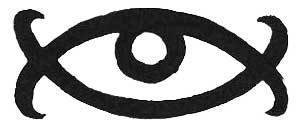Volume XIV, Issue 4,
November 2010
Pages 12 & 13 <previous page > <next page>
Round Robin Training Conversation
November column: a medly of member contributions
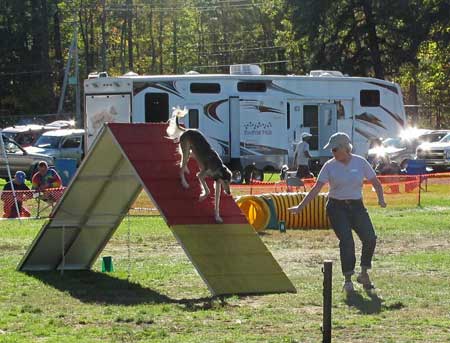
Dara Johnson with Aesop in his NA title run.
Barb Kunze on agility at the BCOA Nationals
Emma isn't quite 2 and has only had 12 lessons. She took one jump and became feral.... So she fell into the entertainer group.
Carol Mount on the challenge she faces
Just thought I'd share video that demonstrates a challenge I face when training my young basenji. The other basenjis I trained were NOT like this. Never quite had dog like this.
http://www.YouTube.com/watch?v=iwwsO7Gwbvk
She has done similar with thin sliced pepperoni, steak, cheese, etc.
Rewarding her during training is sometimes challenging. She runs back to house and into crate with half slice of super thin pepperoni, to the top of Aframe to enjoy, etc.... You'll see she Wants it. It just that she wants to Enjoy every little taste.....
She is getting trained .... Luckily she gets little faster as session goes on.
Lisa Voss
Kenetic Basenjis
NOSE WORK
How We Got Started In Nose Work
I first learned about K9 Nose Work last year when I reading the August Issue of the Whole Dog Journal and saw an article titled "A Fun New Dog Sport, 'Nose Work'". I read the article and thought that this would be a great activity to try with my basenjis. I went to the links to see about classes or a seminar and found that the majority of the classes were in Southern California. The article had a short explanation about getting started but after a couple of tries, I felt I was missing something essential in the process and had no one to ask.
It wasn't until November that I thought about Nose Work again. My good friend and obedience instructor invited me to join a group of people interested in doing tracking with their dogs. In looking into getting that group started she saw that there was an upcoming Nose Work seminar in December and had signed up. I was not able to attend because I was expecting the birth of our singleton, L'Ox. When my friend came back from the seminar she excitedly reported that she thought this would be a great new activity to do with our dogs.
So finally in January, I started Nose Work with a small group dog training friends. We would work in the bike racks at the local schools so we could block off the entrances with ex-pens and the dogs could work off leash. Around this same time, I also found out that there was a nose work class starting near my mom's house in Irvine and I suggested that she might enjoy trying it with one of her dogs. By February, I had started Sophie and Rally in Nose Work and every Thursday would talk to my mom on the phone and we would exchange stories about our training experiences. My mom encouraged me to start L'Ox in nose work early so he started working at home in nose work at 10 weeks old - http://www.youtube.com/watch?v=MIOP79SQ2O4
At the end of March, I decided Sophie was ready to start odor. She was eagerly searching for her food in and out of boxes in a variety of places. We went back to box work, pairing the odor with food in the searches. We spent all of April and most of May paired with food . My mom told me she was going to be doing an Odor Recognition Test at the end of May and encouraged me to attend, confident that Sophie would be ready by then.
I have taken it much slower with L'Ox keeping him on food for a lot longer. He loves his searches and is eager to work but I figured I wanted to be able to really focus on him when I started odor and there is no hurry with nose work. Handlers should take their time and really enjoy working with and learning about their dog as they work. I have also taken it slowly with Rally who often checks in to make sure it is right that she takes the lead on this instead of me. She is such a good girl in rally and agility taking her lead from us that she wants to be sure we really want her expertise on this.
I am now pretty much hooked on Nose Work. The dogs are so excited to see the boxes come out and can't wait for their turn. I love seeing them work and solve the puzzle to find the source of the odor whether it is just their food or whether it is a cotton swab with a drop or two of essential oil. It is such a fun and positive sport and can be enjoyed by handlers and dogs of any age.
Sue Scelzi made pupcakes for nosework class graduation:
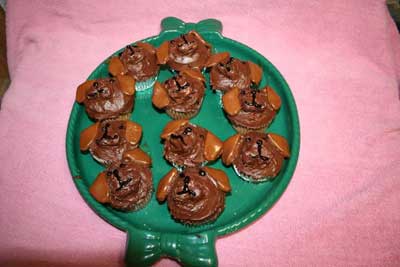
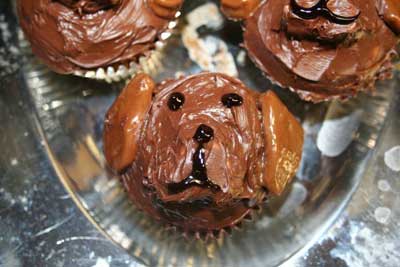
Bonnie Henderson/ A Better Canine Newsletter
abettercanine@sbcglobal.net
Enter the World of Black & White
They say that every dog that comes into our lives has something to teach us. Pique has helped me to see how dogs experience things in a concrete way and live in a world of "black and white" (interestingly enough, her coat is also black and white!) Humans are able to think abstractly and things like: almost, close enough; nice try, etc. regularly enter our dog training sessions. We end up reinforcing effort and not necessarily concrete behaviors. Our dogs respond by repeating the behaviors that get reinforced. Frequently these behaviors were not the desired ones in the first place and are not reinforced anymore. Frustration sets in for both dog and trainer.
People are also generally very uncomfortable with allowing their dogs to make mistakes. They tend to make things easier after the first failed attempt. Many times they resort to luring or coercing the dog to do a behavior. Thus, it is not uncommon for a dog to immediately stop offering behaviors, anticipating that his trainer will offer the lure or make things easier. And then there are the "show me the money" dogs who don't offer behaviors unless the see the desired reinforcement.
Most dogs learn best when things are clear and consistent. That means having an idea of exactly what you expect and reinforcing only what you want. It also means paying attention to how the dog reinforces himself too. When you are asking for a behavior and the dog begins sniffing, he is engaging in a self-reinforcing behavior. By saying his name, calling him, or repeating your signal, you are enabling a pattern of behavior to develop, and when this pattern is reinforced, it will not only continue but even become more likely to occur. Most dogs find their name, and being called reinforcing so the act of calling them when they are inattentive reinforces inattentive behaviors! Then using cookies to reinforce them for becoming attentive teaches them to break attention to get both reinforced by being called and the cookie. Yikes!!!
The simple solution is when you find your dog engaging in an unwanted behavior such as sniffing, running off, or visiting others; calmly and neutrally end your training. At home, I just leave the room or go in the house. When I am training away from home, I quietly leash up my dog and put him or her in a crate. Sometimes we are done and there is no second chance. Other times I will wait a while and try again after a few minutes. Generally there are no third tries. I have had really great results with this. It may sound "mean" or harsh to some, but I think in the long run, it makes things easier on the dog by being so clear. It also prevents me from trying to train while I am feeling frustrated.
Another "black and white" training rule that has become really clear to me has to do with using verbal reinforcement when a dog becomes anxious. This includes "cheering" or consoling stressed dogs. When a dog offers a behavior and you use a verbal response that the dog finds positive, that behavior will grow stronger and will occur with more frequency. So cheering for a dog who has shut down will make it more likely that the very behavior you are trying to stop will not only continue, but it will happen more frequently. Addressing the underlying stress, while working on desensitization and coping skills is the better way to eliminate these behaviors.
I have applied this to becoming more consistent with my contact criteria in competition. For years, Spree's contacts have been perfect in training but terrible at a trial. I began asking for 2 on 2 off positions on all of the contacts in trials and in practice. When he fails to do so, I let him know he didn't do it right (he is very soft so just saying "that wasn't right" or "that was naughty" is enough). The improvement in our qualifying rate is unbelievable. We both seem more comfortable knowing exactly what he is supposed to do.
Finally I have learned to LIKE mistakes and see them as opportunities for learning and problem solving. By embracing them myself, I give off a whole different attitude to my dogs when we train. I no longer get frustrated and can be much more patient with letting them work things out. When they can't, I know we have to see if the skills are really in place and if not, train or retrain those skills. For that, I take responsibility as a trainer.
Bonnie's Spree at the 2008 Invitational
About Salukis doing agility/Dara Johnson
Salukis are a difficult breed, especially at outside trials. There's too much to see - - they ARE sighthounds. I'll bet you'll have better success with indoor trials. RE: zoomies...Salukis ARE running dogs...off lead is like a wine to them...they drink it fast and get very drunk.
I own Salukis and we just got our first AKC Novice Agility title...after 12 trials!!!!! My instructor says, "You'll never know who you're going in the ring with," and she's right...one day slow as molasses, another day zooming around the ring and having fun, and other days (rarely) right on the mark. It seems it's a different issue each trial...refusal at the dogwalk, won't go thru the chute, doesn't want to stay on the table, or headlong pitch over the A frame. Now if I were a better handler???
So, this is what I've discovered in my first year of trialing...
1) I'd rather have a sane Saluki in the ring than a zooming one so I arrive over an hour early and walk/jog that dog for at least a half hour.
2) Performances later in the afternoon produce a saner Saluki as long as it's not hot
3) He hates the heat...becomes slug Saluki
4) Cool AMs he's zoomie Saluki
5) Mostly I do only one event in a day...that wait between the 2 events does ME in and I'm sure he can pick up in that AND he's apt to be zoomie when I'M feeling looney.
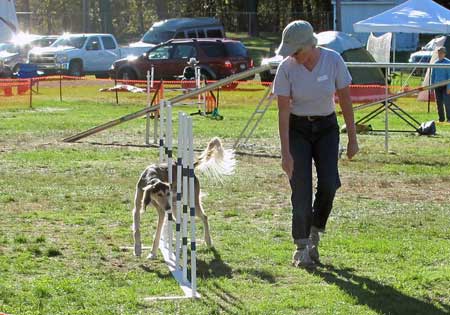
Keep in mind...you ARE in the agility ring with a Saluki. That in and of itself is call for praise. In the American Saluki Association Newsleter, you'll see there are only THREE Salukis that have made it into the AKC top 10 agility salukis IN THE COUNTRY....that's only Salukis; I'm not counting other breeds. This means only three Salukis IN THE COUNTRY got enough points to even get into the standings!
Aesop's First Q
